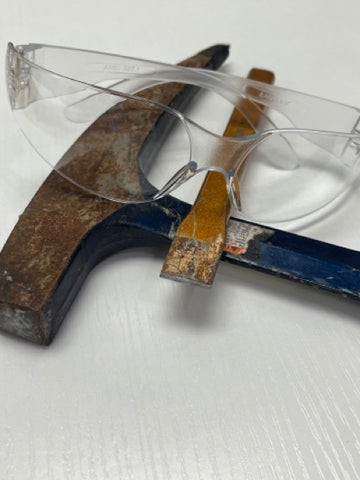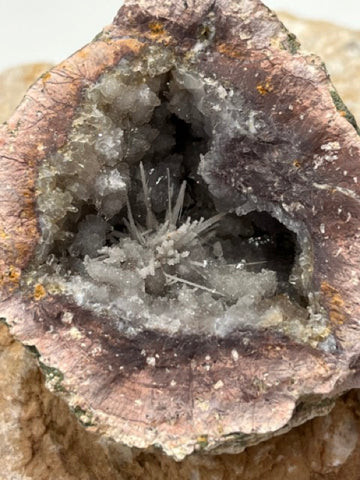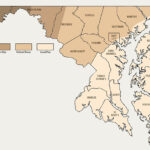Cracking open a rock without a hammer might seem impossible, but there are effective and safe methods you can use to reveal the hidden beauty inside, as we will explore on rockscapes.net. These techniques range from using simple tools to employing more specialized equipment. Let’s dive into how to safely and successfully expose the stunning crystals and minerals concealed within ordinary-looking rocks, using alternative rock breaking techniques and stone splitting methods to bring the wonder of geodes to your fingertips.
1. Understanding Geodes and Their Formation
What Exactly Is A Geode?
A geode is a geological formation that appears as an ordinary rock on the outside but contains a cavity lined with crystals or other mineral matter. These natural wonders are typically spherical or oblong and are formed through various geological processes over thousands to millions of years. According to research from Arizona State University’s School of Earth and Space Exploration, geodes are often found in volcanic or sedimentary rocks, where mineral-rich water seeps into cavities, depositing crystals over time.
How Do Geodes Form?
Geode formation is a fascinating process. It begins with a hollow pocket in a rock, often created by gas bubbles in volcanic lava or the dissolution of soluble minerals in sedimentary rocks. This cavity then becomes a site for mineral deposition. Mineral-rich water percolates through the surrounding rock and seeps into the hollow space. As the water evaporates, it leaves behind dissolved minerals, which slowly crystallize on the inner walls of the geode. The type of minerals deposited determines the kind of crystals that will form inside. Common minerals found in geodes include quartz, amethyst, calcite, and celestite. Over time, layer upon layer of crystals build up, creating the stunning formations we see when we crack open a geode.
2. Safe Alternatives To Using A Hammer
1. Geode Cracker (Soil Pipe Cutter)
What Is A Geode Cracker?
A geode cracker, also known as a soil pipe cutter, is a specialized tool designed to break open geodes without damaging the crystals inside. This tool is particularly useful for geodes that are difficult to crack with simpler methods. It applies even pressure around the circumference of the geode, making it more likely to split cleanly into two pieces.
How To Use A Geode Cracker
- Placement: Place the geode in the chain jaws of the geode cracker, ensuring it is stable and centered.
- Tightening: Gradually tighten the cutter around the geode. The pressure should be applied evenly to avoid shattering the rock.
- Breaking: Continue tightening until the geode cracks open, revealing the interior.
Benefits Of Using A Geode Cracker
- Precision: Provides a clean break, minimizing damage to the crystals inside.
- Efficiency: Works well on harder geodes that are difficult to crack with other methods.
- Safety: Reduces the risk of flying debris compared to using a hammer.
2. Using A Screwdriver As A Wedge
How To Use A Screwdriver And Mallet
- Preparation: Place the geode on a stable surface.
- Positioning: Position the tip of a sturdy screwdriver along the desired line of the break.
- Tapping: Gently tap the back of the screwdriver with a mallet to create a small notch.
- Wedge: Increase the force gradually, using the screwdriver as a wedge to split the geode.
Tips For Using A Screwdriver
- Use a sturdy screwdriver with a handle that can withstand repeated impacts.
- Work slowly and methodically, applying even pressure to avoid shattering the geode.
- Consider wrapping the geode in a cloth to contain any flying fragments.
3. The Chisel Method Without A Hammer
Utilizing A Manual Chisel
- Secure The Geode: Position the geode on a solid, level surface.
- Position The Chisel: Place the chisel’s edge where you want to initiate the split.
- Apply Pressure: Use your body weight or hand pressure to push the chisel into the geode along the intended line.
- Wedge And Split: Steadily increase pressure to wedge the geode apart.
Choosing The Right Chisel
- Select a cold chisel made from hardened steel for effective rock splitting.
- Ensure the chisel has a comfortable grip for sustained manual pressure.
- A wider chisel edge can distribute force more evenly, reducing the risk of shattering.
4. Utilizing Temperature Differences
How To Use Temperature To Crack Rocks
- Heating: Place the geode in a warm oven (around 200°F or 93°C) for about an hour.
- Cooling: Quickly transfer the heated geode to a bucket of cold water.
- Cracking: The rapid temperature change can cause the geode to crack along its natural fault lines.
Important Considerations
- This method is not always reliable and may not work on all types of geodes.
- Extreme temperature changes can sometimes damage the crystals inside, so use this method with caution.
5. Using A Wet Tile Saw
What Is A Wet Tile Saw?
A wet tile saw is a power tool commonly used for cutting tiles, but it can also be used to cut geodes. The water-cooled blade minimizes dust and heat, providing a smoother cut.
How To Use A Wet Tile Saw
- Safety Gear: Wear safety goggles and gloves to protect yourself.
- Water Supply: Ensure the saw has a continuous water supply to keep the blade cool.
- Cutting: Slowly feed the geode into the blade, allowing the saw to do the work. Avoid forcing the geode, which can cause the blade to bind or shatter.
Benefits Of Using A Wet Tile Saw
- Precision Cutting: Provides a clean, precise cut, ideal for preserving the crystals inside.
- Dust Reduction: The water-cooled blade minimizes dust, making it safer to use.
- Versatility: Can be used on a variety of stone types and sizes.
6. Slab Saw
What Is A Slab Saw?
A slab saw is a specialized lapidary equipment designed for cutting rocks and minerals. It uses a thin, diamond-coated blade to make precise cuts. This method is ideal if you plan to polish the face of the cracked geode.
How To Use A Slab Saw
- Safety Measures: Always wear safety goggles and gloves.
- Secure The Geode: Secure the geode in the saw’s vice or holder.
- Cutting Process: Slowly and steadily feed the geode into the blade, allowing the saw to cut through the rock.
- Coolant: Ensure the saw has an adequate supply of coolant (usually oil or water) to keep the blade cool and prevent dust.
Advantages Of Using A Slab Saw
- Precision: Provides very clean and precise cuts.
- Crystal Preservation: Minimizes damage to the crystals inside.
- Ideal For Polishing: Perfect for preparing geode faces for polishing.
3. Safety Practices For Cracking Open Rocks
Essential Safety Gear
- Safety Goggles: Always wear safety goggles to protect your eyes from flying rock fragments.
- Gloves: Use gloves to protect your hands from sharp edges and potential cuts.
- Dust Mask: Work in a well-ventilated area or wear a dust mask to avoid inhaling dust particles.
General Safety Tips
- Stable Surface: Always work on a stable surface to prevent the geode from shifting during the cracking process.
- Controlled Force: Apply force gradually and in a controlled manner to avoid shattering the geode and its contents.
- Awareness: Be aware of your surroundings and keep a safe distance from others to prevent injuries from flying debris.
- Supervision: If children are involved, ensure they are supervised by an adult at all times.
4. Exploring Different Types Of Rocks
Common Types Of Rocks
- Sedimentary Rocks: Formed from accumulated sediments like sand, mud, and organic matter. Examples include sandstone, limestone, and shale.
- Igneous Rocks: Formed from cooled and solidified magma or lava. Examples include granite, basalt, and obsidian.
- Metamorphic Rocks: Formed when existing rocks are transformed by heat, pressure, or chemical reactions. Examples include marble, slate, and gneiss.
Identifying Rocks
Identifying rocks involves examining their physical properties such as color, texture, hardness, and mineral composition. Resources like the Peterson Field Guide to Rocks and Minerals can be invaluable for rock identification.
Rocks In Landscaping
Rocks play a crucial role in landscaping, providing both aesthetic appeal and functional benefits. They can be used to create rock gardens, pathways, retaining walls, and water features. Different types of rocks offer unique textures, colors, and shapes that can enhance the overall design of a landscape.
5. Where To Find Rocks In The USA
Best Locations For Rock Hunting
- Arizona: Known for its diverse geological formations, Arizona offers a wide variety of rocks and minerals, including turquoise, copper minerals, and geodes. According to the Arizona Geological Survey, areas around Tucson and Quartzsite are particularly rich in mineral deposits.
- California: California’s varied landscapes, from the Sierra Nevada mountains to the Mojave Desert, are home to numerous rockhounding sites. Jade, serpentine, and gold are among the sought-after finds.
- Oregon: Oregon is famous for its agates, petrified wood, and thundereggs. The state’s coastal regions and high desert areas are prime locations for rock hunting.
- Texas: Texas offers a variety of rocks and minerals, including petrified wood, agate, and fossils. Central Texas and the Big Bend region are popular among rockhounds.
Tips For Rock Hunting
- Research: Before heading out, research the specific locations you plan to visit to understand what types of rocks and minerals are commonly found there.
- Tools: Bring essential tools such as a rock hammer, chisel, safety goggles, gloves, and a sturdy bag or backpack for collecting your finds.
- Permissions: Obtain permission from landowners before collecting rocks on private property.
- Regulations: Be aware of any local, state, or federal regulations regarding rock collecting. Some areas may have restrictions on the quantity or type of materials you can collect.
6. Rockscapes.net: Your Resource For Rock Information
What Is Rockscapes.net?
Rockscapes.net is a website dedicated to providing comprehensive information about rocks, minerals, and their applications in landscaping and design. Whether you’re a homeowner, landscape designer, or rock enthusiast, Rockscapes.net offers a wealth of resources to inspire and inform.
How Can Rockscapes.net Help You?
- Design Ideas: Explore a wide range of landscape design ideas featuring rocks and stones.
- Rock Identification: Learn how to identify different types of rocks and minerals.
- Construction Tips: Get step-by-step guidance on building rock gardens, pathways, and other landscape features.
- Supplier Listings: Find reputable suppliers of rocks and stones in your area.
- Maintenance Advice: Discover tips for maintaining and caring for your rock landscapes.
Contact Information
For more information, you can contact Rockscapes.net at:
- Address: 1151 S Forest Ave, Tempe, AZ 85281, United States
- Phone: +1 (480) 965-9011
- Website: rockscapes.net
7. Design Ideas For Rock Landscapes
Rock Gardens
Rock gardens are a beautiful and low-maintenance way to incorporate rocks into your landscape. They typically feature a variety of rocks and alpine plants arranged to mimic a natural mountain environment.
Creating A Rock Garden
- Planning: Choose a sunny location with well-draining soil.
- Rock Selection: Select a variety of rocks in different sizes, shapes, and colors.
- Placement: Arrange the rocks in a natural-looking pattern, burying about one-third of each rock to give it a more established appearance.
- Planting: Plant alpine plants and succulents in the spaces between the rocks.
Pathways
Rocks can be used to create attractive and durable pathways in your garden. Stepping stones, gravel paths, and rock borders can add texture and visual interest to your landscape.
Building A Rock Pathway
- Preparation: Clear the area where you want to build the pathway.
- Base Layer: Lay down a base layer of gravel or crushed stone for drainage.
- Rock Placement: Arrange the rocks in a pattern that is both aesthetically pleasing and easy to walk on.
- Securing: Secure the rocks in place with sand or soil.
Water Features
Rocks can be incorporated into water features such as ponds, streams, and waterfalls to create a natural and tranquil environment.
Designing A Rock Water Feature
- Planning: Choose a location that complements your landscape design.
- Rock Selection: Select rocks that are appropriate for use in water, such as river rocks or flagstones.
- Construction: Build the water feature according to your design, using the rocks to create waterfalls, pools, and streams.
- Planting: Add aquatic plants to enhance the natural appearance of the water feature.
8. Maintaining Rock Landscapes
Cleaning Rocks
Over time, rocks in your landscape can become dirty or stained. Cleaning them regularly will help maintain their appearance.
Cleaning Methods
- Hose: Rinse the rocks with a garden hose to remove loose dirt and debris.
- Scrubbing: Use a scrub brush and mild detergent to remove stubborn stains.
- Pressure Washer: For larger rocks, a pressure washer can be used to blast away dirt and grime.
Weed Control
Weeds can be a nuisance in rock landscapes. Regular weed control is essential to keep your landscape looking its best.
Weed Control Strategies
- Hand Pulling: Manually pull weeds from the rock landscape.
- Herbicides: Apply herbicides to kill weeds. Be sure to choose a product that is safe for use around your plants and pets.
- Mulch: Apply a layer of mulch around the rocks to prevent weeds from germinating.
Repairing Rock Structures
Over time, rock structures such as retaining walls and pathways may require repairs.
Repair Tips
- Loose Rocks: Replace any loose or missing rocks.
- Cracks: Fill any cracks in the rocks with mortar or epoxy.
- Drainage: Ensure that the drainage is functioning properly to prevent water damage.
9. The Benefits Of Using Rocks In Landscaping
Aesthetic Appeal
Rocks add natural beauty and visual interest to any landscape. Their unique textures, colors, and shapes can enhance the overall design and create a sense of harmony.
Low Maintenance
Rock landscapes are generally low maintenance, requiring less watering, fertilizing, and mowing than traditional lawns and gardens.
Durability
Rocks are durable and long-lasting, making them a sustainable choice for landscaping. They can withstand harsh weather conditions and resist wear and tear.
Erosion Control
Rocks can be used to control erosion on slopes and hillsides. They provide a barrier that prevents soil from washing away during heavy rains.
Water Conservation
Rock landscapes require less water than traditional landscapes, making them a water-wise choice for arid and semi-arid regions.
10. Frequently Asked Questions (FAQ)
What Is The Best Way To Clean Rocks In My Landscape?
The best way to clean rocks in your landscape depends on the size and type of rock, but generally, start with a garden hose to remove loose debris. For more stubborn stains, use a scrub brush with mild detergent or a pressure washer for larger stones.
How Can I Prevent Weeds From Growing In My Rock Garden?
To prevent weeds in your rock garden, manually pull weeds regularly, apply herbicides carefully, and use a layer of mulch around the rocks to block sunlight and prevent weed germination.
What Are The Best Types Of Rocks For A Water Feature?
The best types of rocks for a water feature are those that are water-resistant and aesthetically pleasing, such as river rocks, flagstones, and slate. Ensure the rocks are stable and safe for aquatic life if you have a pond.
How Do I Choose The Right Size Rocks For My Landscape?
Choose rock sizes that are proportional to your landscape. Larger rocks can be focal points in bigger spaces, while smaller rocks are better for pathways and smaller gardens. Consider the overall design and ensure the rocks complement the surrounding elements.
Where Can I Find A Variety Of Rocks For Landscaping In The USA?
You can find a variety of rocks for landscaping at local quarries, landscape supply stores, and rock yards. States like Arizona, California, and Texas are known for their diverse geological formations and abundant rock resources.
Can I Use Rocks From My Own Property For Landscaping?
Yes, you can use rocks from your own property, but ensure you are not disturbing protected areas or violating any local regulations. Clean the rocks thoroughly before incorporating them into your landscape design.
What Are The Benefits Of Using Rocks Instead Of Mulch In My Garden?
Rocks offer long-lasting durability and require less frequent replacement than mulch. They also provide better erosion control and can add a unique aesthetic appeal to your garden.
How Do I Repair A Rock Retaining Wall?
To repair a rock retaining wall, replace any loose or missing rocks and fill cracks with mortar or epoxy. Ensure the wall has proper drainage to prevent water damage and future issues.
Are There Any Safety Precautions I Should Take When Working With Rocks?
Yes, always wear safety goggles and gloves to protect yourself from sharp edges and flying debris. Use appropriate lifting techniques to avoid back injuries and work on a stable surface.
How Does Rockscapes.Net Help With Landscaping Projects?
Rockscapes.net provides a wide range of resources, including design ideas, rock identification guides, construction tips, and supplier listings to help you plan and execute your landscaping projects effectively.
Discover the beauty and versatility of rocks and let rockscapes.net inspire your next landscaping project. Whether you’re creating a rock garden, pathway, or water feature, the possibilities are endless. Visit rockscapes.net today and unlock the potential of rock landscaping.
 Geode cracking supplies including a stone chisel, hammer, and safety glasses
Geode cracking supplies including a stone chisel, hammer, and safety glasses
 Close-up of Crystal Canyon Geode with needle quartz
Close-up of Crystal Canyon Geode with needle quartz
